Ladakh
Things to DO
Nubra Valley
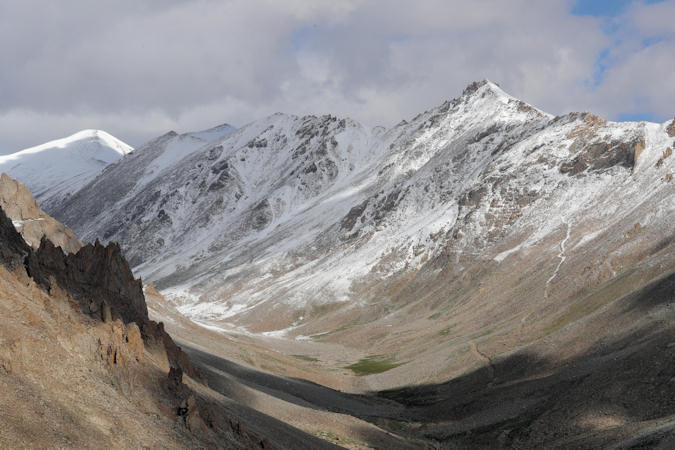 |
|||||
Nubra Valley ("the valley of flowers") is where the Shyok and Siachan rivers meet to form a large valley that
separates the Ladakh and Karakoram Ranges.
Like the rest of the Tibetan Plateau, Nubra is a high altitude cold desert with rare precipitation and scant vegetation except
along river beds. The villages are irrigated and fertile, producing wheat, barley, peas, mustard and a variety of fruits and nuts,
including blood apples, walnuts, apricots and even a few almond trees.
To reach Nubra valley, you will have to cross the awe-inspiring Khardung La (5.359 m), one of the highest motorable pass
in the world. Khardong La is historically important as it lies on the major caravan route from Leh to Kashgar in Central Asia.
About 10.000 horses and camels used to take the route annually, and a small population of Bactrian camels can still be seen at
Hunder, in the area north of the pass.
Hunder village is popular with Indian visitors, who settle into one of the dozens of guesthouses and tent camps, and
then spend the late afternoon exploring the photogenic sand dunes 3km from town.
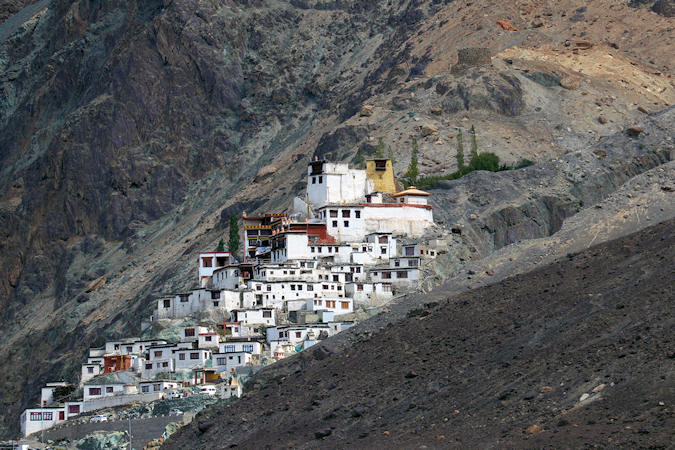 |
|||||
Diskit Monastery belongs to the Gelugpa (Yellow Hat) sect of Tibetan Buddhism. It was founded by Jangsem Sherap
Zangpo, a disciple of Tsongkhapa, founder of Gelugpa, in the 14th century.
The monastry has quite an interesting legend attached to it. It is believed that a Mongol demon once lived here and was considered
to be a sworn enemy of Buddhism. He was annihilated near the monastery. However, even after his death, his body kept coming back
to the monastery again and again. It is said that even today the wrinkled head and hand of the demon lie inside a temple of the
monastery, which is filled with fierce Gods and Goddesses.
On top of a hill below the monastery, an impressive 32 m Maitreya Buddha constructed April 2006, was consecrated by the Dalai
Lama on 25 July 2010.
Leh-Kargil route
For most part, the Leh-Kargil route (218 km) transited through extremely treacherous terrain and followed the historic trade route along the Indus River, giving travelers a glimpse of villages which are historically and culturally important. The road generally remained open
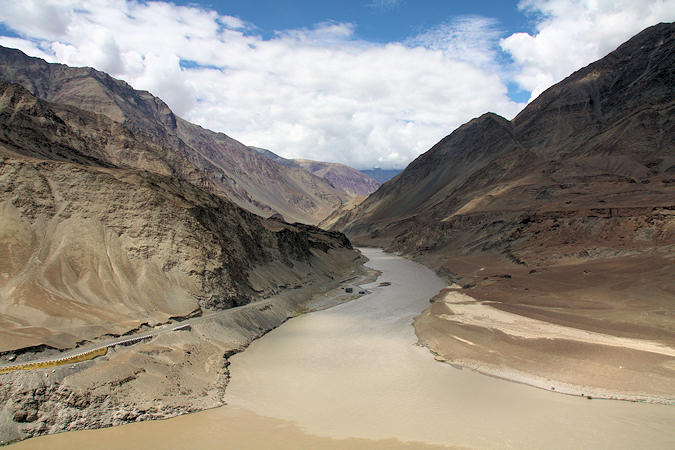 |
|||||
for traffic from early June to mid-November.
The two highest passes on this route include Fotu La at 4.108 m elevation and Namika La at 3.700 m.
The most popular stops en route are at Basgo, Alchi and Saspol Caves.
Fondly known as Moonland amongst the locals here, near Lamayuru, about 125 km ahead of Leh, is quite certainly Moon
on Earth. The soft craters, orangish yellow land simply add charm to the surreal beauty this area.
Around 45 kilometre east of Kargil, is the famous Chamba Statue in Mulbekh village, a striking enormous figure carved into
the rock face on the left hand side of the road. It pictures a standing Maitreya Buddha or Buddha-to-come overlooking the old
trade route and modern highway. The statue is believed to have been carved in the 8th-Century, and has been guarding travelers on
this path over the centuries.
Unfortunately, the lower part of the statue is partly obscured by a small temple built in 1975.
1) Basgo
A historical site, Basgo about 35 km from Leh, was once strategically located on the trade route (with access to the
Silk Road and Kashmir) at the juncture of Upper and Lower Ladakh, and used to be the final staging point for caravans and travellers.
Within a radius of two kilometres, one encounters the remains of an Ancient Fort, three Temples with beautiful
paintings, ruins of a Royal Palace, animal stables, residence of ministers and nobility, and a large number of Chortens
(stupa) of varied shapes, size and antiquity.
The remains of a temple dating back to the 11th century, and a chorten (stupa) associated with Rinchen Zangpo (958–1055 AD),
the "great translator", are a testament to the antiquity of Basgo.
In the first quarter of the 15th century CE, Gragspa Bum received Basgo as part of a political settlement with his brother
Gragspa Bum-lde, who ruled Ladakh from Shey (1410–1440). Gragspa Bum-lde played a significant role in the establishment of
the newly formed Gelugpa Order when he received the first emissaries to Ladakh and subsequently commissioned the building of
the first Yellow Hat Monastery at Spituk.
The grandson of Gragspa Bum, Lhachen Bhagan (1460–1485), deposed the son of Gragspa Bum-lde and his ascension marked the start
of the second Ladakhi dynasty. With the shift in the seat of power, building activity in and around Basgo increased.
An inscription found in the Gonkhang on Namgyal Hill in Leh records that Tashi Namgyal (1555–1575) commissioned a monastery
near the Royal Palace at Basgo. His son Tsewang Namgyal (1575–1595), became one of Ladakh’s most prominent rulers and he
commissioned the painting inside the Chamba Lhakhang.
Senge Namgyal (1616-1642) married Kalzang Drolma, a princess from Rupshu, whose name is associated with the small temple,
Cham Chung. She is also believed to have favoured the Yellow Hat Gelugpa sect, thus accounting for the image of Tsonkhapa
(the founder of Gelug order) in the small temple. Senge also invited Stagsan Raspa to Ladakh and the latter, on arrival,
took on the role of the spiritual teacher of the King and secured his support for the Drugpa Lineage. He set up several major
monasteries, with Hemis monastery as the centre of the Drukpa school in Ladakh.
At Basgo, Senge Namgyal commissioned the two-storey tall copper/gold Maitreya statue, close to the royal palace in the
Chamba Serzang.
After Senge Namgyal shifted to his new palace in Leh, Basgo lost its pre-eminent position, although its strategic significance was
reasserted many times thereafter. It was with the arrival of the Dogra General Zorawar Singh from Kashmir in 1834 and
the subsequent pillage of the Basgo fort by his soldiers that the site finally went into decline, with only three temples surviving.
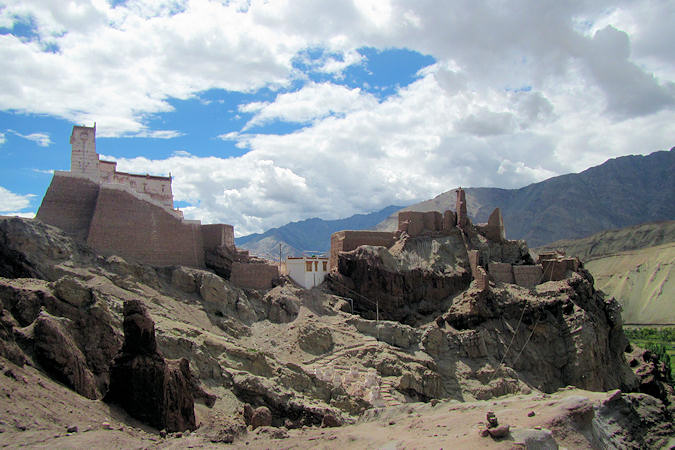 |
|||||
Basgo Khar (Fort)
The fort was designed as a self-contained township with the capacity to withstand a siege almost indefinitely. A series of
independent watchtowers of rammed earth with triangular loopholes located strategically at the highest points of the landscape
formed the outermost layer. This was followed by a wall all around the perimeter to the south and east of Basgo Hill. Only
some sections of the wall are extant today.
Royal Palace
The eastern face of the fort complex is dominated by the ruins of the royal palace. The ruins suggest that the palace was
multi-storeyed—and the lower floors constructed with dressed stone laid in the precise course highlight a detailed Tibetan
craftsmanship. On a ledge at the top of the balcony is a "lato" (collection of branches to ward off the evil eye);
which is renewed in a ritual function annually.
Chortens
Basgo has a rich representation of chortens in various shapes, sizes and antiquity.
A "stepped chorten" (ladder type) with a star-shaped base at the east end of the village, is particularly significant,
as the construction is attributed to Rinchen Zangpo.
Another significant chorten is located close to the base of the Basgo Hill, near what would have been the traditional entry to
the fort
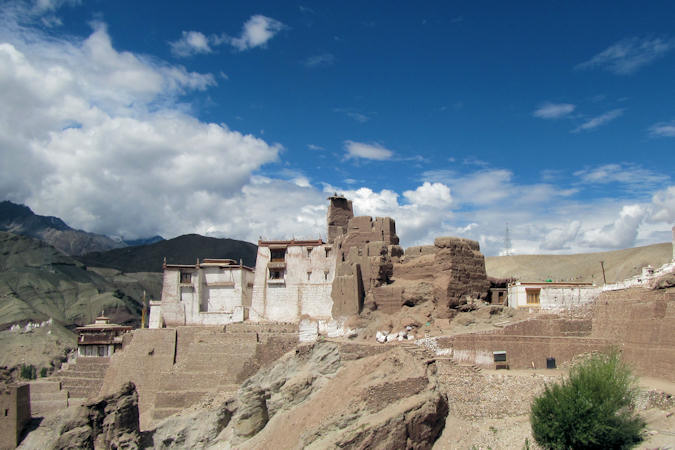 |
|||||
complex. This is a "kakani chorten" (passage), open on all four sides. The wooden ceiling and the walls above
the openings have remnants of exquisite paintings similar to small Buddha-like figures in multiple rows. The faint traces of the
surviving original paint suggest an early 13th–14th century painting.
Three Maitreya (Chamba) Temples
The largest of the three Maitreya temples, the Chamba Lhakhang is nestled at the highest point in an alcove of ancient
rammed earth fort walls. At the edge of a terrace below the Serzang temple is an unusual structure popularly known as
Cham Chung. The structure resembles a Balti (or Central Asian) mosque, with the typical conical roof over a square central
lantern rising above the main roof.
The temple façades are brightly painted and their interior walls are covered with murals depicting vignettes from the life of
Buddha and portraits of the temples’ benefactors. The largest of the three structures holds a 14-meter-high, gilded statue of the
Maitreya Buddha.
2) Alchi
The monastery complex was built, according to local tradition, by the great translator Guru Rinchen Zangpo between 958 and
1055 AD. Rinchen Zangpo had been sent as a young man by King Yeshe-Ö, the ruler of Zanskar, Guge, Spiti and Kinnaur, with other
young scholars to Kashmir and other Buddhist centres to study and bring back Buddhist teachings to Western Tibet. His biographer
writes that when Rinchen Zangpo departed from Kashmir, he brought with him a large number of Buddhist texts as well as thirty-two Kasmiri
artists. He is believed to have constructed one hundred and eight temples across Western Tibet.
The artistic and spiritual details of both Buddhist and the Hindu kings of the time in Kashmir and Himachal Pradesh are reflected
in the wall paintings in the monastery. The best preserve scenes are the so-called "Banquet scenes", which show kings, queens,
nobles and courtiers indulging as wine are being poured into goblets of the male figures. It is only in Alchi that such secular scenes,
which are otherwise taboo in Buddhist monastries, are seen.
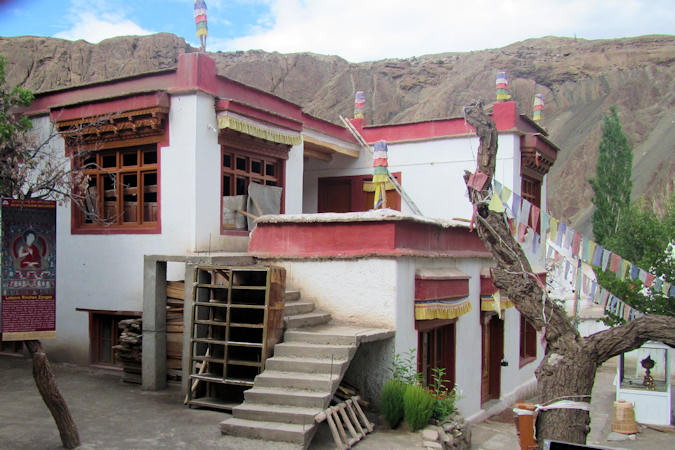 |
|||||
The female figures, most expecially the "Green Tārā" are marked by exquisite designs. Tārā is seen clad with an immaculately cut
blue blouse and skirt, her swelling breasts bursting out from the blouse. Across Ladakh, she is the favourite female deity.
In Tibetan Buddhism, Mandalas are two-dimensional residence of dieties of a particular Buddha family, where the main deity
presides in the centre and is surrounded by a retinue of other deities and attendants. Mandalas are spiritual guidelines for the
practitioners who use them as aids to abtain the body of the Buddha.
At Alchi, the mandalas of Vairocana are prominently dipicted on
the walls of both the Sumtsek and Dukhang shrines.
At the centre of the mandala are the Five Tathāgatas Buddhas and four goddesses. Each of
these nine squares containing images of the deities are separated from the others by lines of elongated gilded varjras with knobs.
In the next square are sixteen bodhissattvas and four sets of inner and outher offering deities. At the corners in outside off the circle
of the mandala are the Four Guardian Dieties, making a total of thirty-seven divinities.
The Five Tathāgatas are Varocana (white) seated at the centre of the mandala; Akṣobhya (blue), the buddha of the east;
Amitābha (red), the buddha of the west; Ratnasambhava (yellow), the buddha of the south; Amoghasiddhi (green),
buddha of the north.
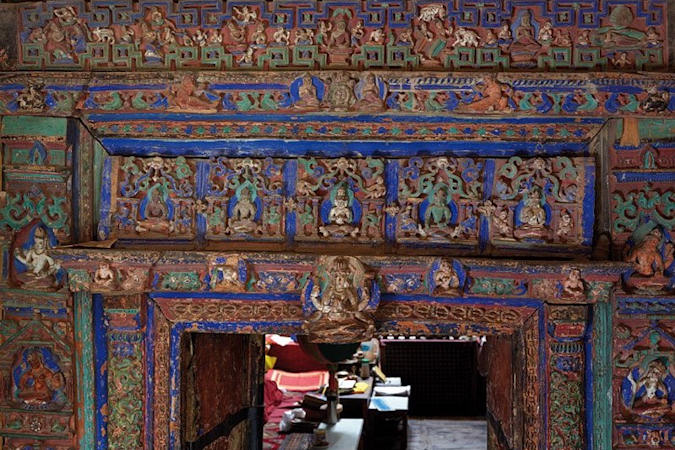 |
|||||
Dukhang or the Assembly Hall is at the heart of the monastery complex, where monks perform worship and ceremonies. It is
large and ancient, and the original wooden door frame is retained.
Many additions were made to the ancient structure during the 12th and 13th centuries.
The carved wooden gate is made in the shape of a mandala to instil upon visitors that they are not entering into a ordinary hall, but
rather into the pure land of Vairocana.
The colonnaded veranda leads to the hall from a front courtyard and frescoes of one thousand Buddhas are depicted in the passageway.
A two-armed Mahākāla can be seen at the outer gate.
The clay statue of Vairocana is the main image of the Dukhang and is installes in the room's central alcove.
A Caretaker Monk has been appointed by Likr Monastry to look after Alchi Choskor and to perform the necessary rituals there for
a period of three years.
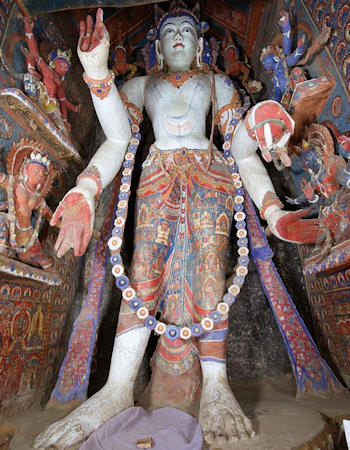 |
|||||
The Sumtseg Temple in the Alchi complex is one of the most outstanding, but its purpose is not clearly established. The
Sumtseg, means a three storied building, though small, was built with loam and natural stone (reflected in the bland exterior) in the
Tibetan building tradition. However, the luxuriant woodwork columns, facades, walls, clay images and paintings in the interior of the
monastery were made by Kashmiri artists.
The niches on the ground floor depict the main images of three Bodhisattvas (all in standing posture and about 4 metres in height)
and its associate secondary deities (four in each niche) with two flying goddesses in each niche.
Image of Maitreya, the largest in size (4.63 metres), is deified on the back wall and flanked by the images of Avalokiteśvara
to its right and Manjuśrī to its left. Iconographically, the deities have a single head with four arms but differently portrayed. Each
deity is identified to a different Buddha. Maitreya has a five Buddha crown representing Vairochana. Avalokiteśvara's crown
represents Amitābha and Manjushri's crown represents Akṣobhya.
An inscription in the main niche states that the three images are reliquaries representing body, speech and mind-compared to the
three bodies of the Buddha-namely, Maitreya denoting the Buddha body of reality, Avalokiteśvara representing pure rapture and Manjuśrī
representing emanational body. In simple terms, they represent the Buddhist concepts of "Compassion, Hope and Wisdom".
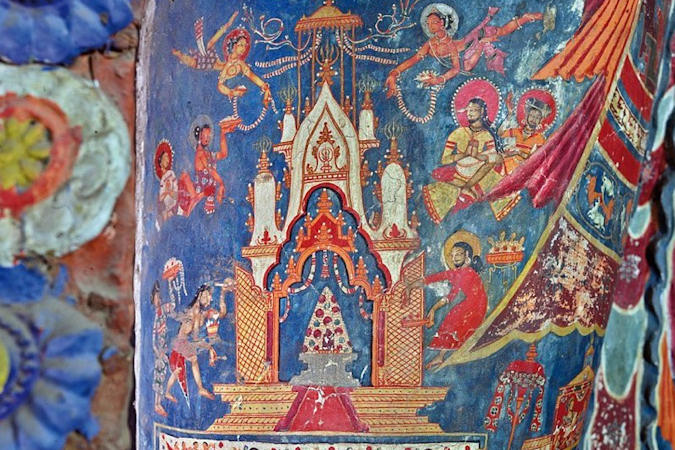 |
|||||
All three standing Bodhisattvas wear a "dhoti", or a cloth tied around the waist that covers the legs. These lower garnments
depict scenes with a multitude of historical and cosmic figures.
The scenes depicted on the lower robe of Avalokiteśvara are quite complex and do not have a uniform theme. There are depictions of
palaces, temples with tridents on their rooftops, priests with knotted hair engaged in worship and various prominent Hindu gods.
(Shiva, Brahma, Ganesha, Vishnu).
On the robes of Maitreya are depictions of the main events that mark the life time of Gautama Buddha, between the last journey
in "Tushita" heaven and the first sermon in "Sarnath".
On the lower garments of Manjuśrī are depictions of the eighty-four "Mahasiddhas", the enlightened Indian masters of Mahāyāna
Buddhism. Set on a chequered board, these figures are shown seated in the company of disciplesand female partners in different
postures and positions.
3) Saspol Caves
Believed to have dated back to the 13th-15th centuries, the Saspol Caves are located across the river Indus about 65 kilometres
west of Leh.
Carved into the face of the mountain, the Saspol Caves appear, at first glance, to be slightly larger than pigeonholes. It is only
the entrance to the main cave, whitewashed, and outlined with red ochre, that draws our attention towards them.
There are five caves in all, two of the caves are painted, and it is the so-called "Cave 3" where most of the paintings are
still intact.
The central figure in this cave is that of the Śākyamuni Buddha, on
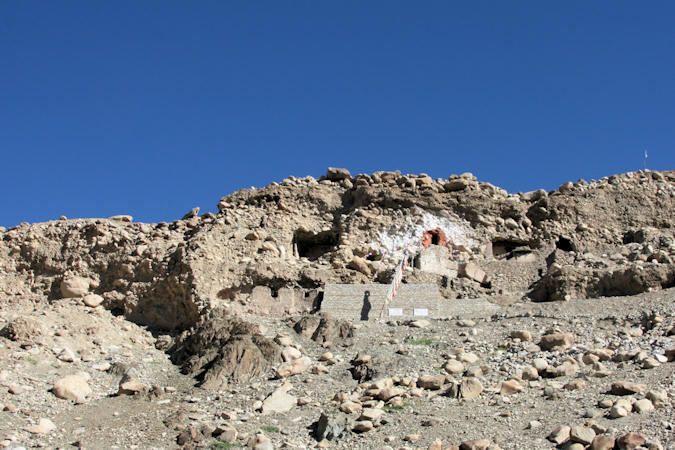 |
|||||
the northwestern wall, facing the entrance.
The southern wall has a depiction of a eleven-headed and thousand-armed Avalokiteśwara (a Bodhisattva who embodies the
compassion of the Buddhas), flanked by two monks and surrounded by eleven medallions, which depict other monks
Next to them is an unusual depiction of the Bodhisattvas Manjuśrī (associated with insight), and Maitreya (the future
Buddha), in conversation with each another. They are identified by their attributes — a book and sword for Manjushri and an ewer and
three stupas for Maitreya, shown placed on lotus steles next to them.
Caves have been created by proponents of Drikung Kagyu, Tibetan Buddhist School. The main concentration was on the meditative
practices.
The fascinating trait of these paintings are the miniatures that portray Hevajra, an Ishta
Deva, a state of enlightenment which is achieved at the final stage of meditation.
Kargil
Kargil is the main town in the historical region of Purig, which consists of the Suru river basin.
Earlier, Purig consisted of a number of small but independent kingdoms, which included Pashkum, Chiktan, Fokar, Soth and the Suru Valley.
These tiny principalities would often fight among themselves over petty issues.
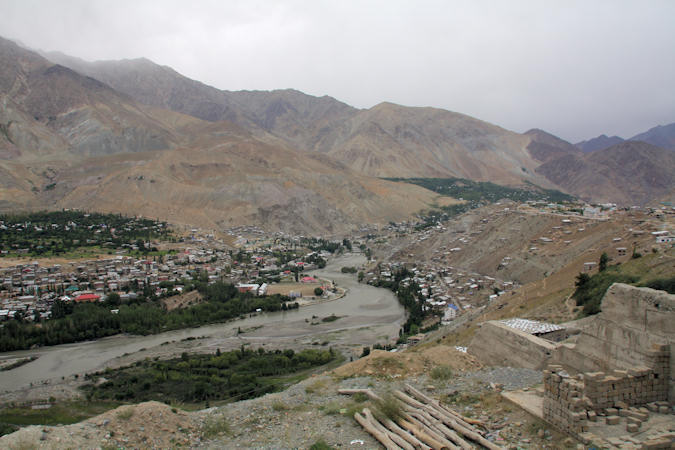 |
|||||
Gasho “Thatha Khan”, an exiled prince in the AD 9th century, is perhaps the first ruler who brought together
all the territories under a united administration. Another sultan of Purig extended his kingdom to include Zanskar, Sot, Barso,
Sankoo pretty much the territory of the present Kargil district. He is referred to as “The Purig Sultan”.
It is said that it was the period of Ali Sher Khan Anchan, the famous ruler of Skardu, in the late 16th and early 17th
centuries which had a great influence on the area. This prince from Baltistan conquered most of the principalities of Purig
and introduced Balti culture in the Kargil district.
Subsequently, it was the Dogras who united Baltistan, Purig, Zanskar and present-day Leh district in the first half of the
19th century under a single administrative unit, which lasted until 1947 when a new line of control was demarcated between India
and Pakistan separating Skardu and Kargil.
Nowadays Kargil is simply an overnight halt on the way to Srinagar or the point where you turn south to the Zanskar Valley.
The people of Kargil are chiefly Muslim and noted for their extreme orthodoxy.